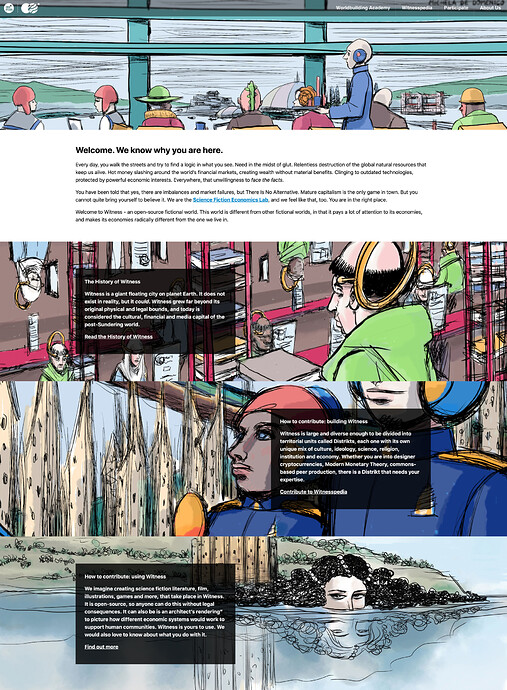Update on where we are on the Witness game (and many clarifications). The context to this is that @MariaEuler generously kept scheduling calls, but for various stupid reasons I missed them, so I must do my penance in writing.
0. General TL;DR on Witness: the Game
This is a card game for 1-3 players*. Each player controls a distrikt under seige from various events - from market crashes to tsunamis. Each player can select and play a limited number of policies to help guide their society through as many events as possible. Damage to distrikts is measured along three indicators: infrastructure, economy, public opinion. The game ends when there is only one distrikt left alive or you have survived for a certain number of events.
1. State of the game right now
As of right now, Witness: The Game is essentially a spreadsheet.
This spreadsheet contains data items that represent the cards we will create for the game. These cards events that will happen in the game and the policies that players can use to counter these events.
In a classical card game of this type, a card looks like this:
Our cards are simpler, but follow roughly the same organization.
For policies, there is an illustration; a card name*; a type line that shows which Distrikt the card is from; a text box containing flavor text that describes what the card does.
For events, the organization is much the same.
As mentioned before, Witness: The Game is essentially a spreadsheet right now. The data items are the relevant for each event and the policies of three distrikts: the Covenant, the Assembly and Hygge.
We have created the basic details of the cards; we’ve also written flavor text and designed the mechanical workings of the policies; now we’re in the stage of balancing - adjusting the power and toughness of each card, and testing different rules of play so that the game stays fun, is easy to pick up, and can let a user understand, by playing, the kind of relationships we’ve been talking about between these social contracts, mutant economies and the people who make them work.
Once balance, we output the complete spreadsheet - containing all the textual items needed for Witness: the game - as well as a set of game rules. We’re about 65% of the way there: events and policies need to be rebalanced (events now deal too much damage to too many categories, like real events; this level of reality might be interesting to some but is boring to play against because you lose in 2-3 events no matter what; reducing this to 1-2 types of damage per event allows strategy and fun), a few new cards need to be created, and we need to add flavor text for events (shorter and easier than for policies, but more numerous).
How we test at this phase is typically by printing the card text out on paper or cardboard and playing with them. Occasionally, while playing, we make corrections to the cards, test them, and note the corrections. This is a very mechanical process, as it combines some top-down ideas (eg: okay, let’s capture political inertia in Hygge by making players collect n numbers of the same card to play powerful policies) and bottom-up design by playing and reiterating.
ETA: end August. This is the meat of the game. We’re about four days behind schedule (because I spent too much time trying out a particular mechanic for Libria) but on track to catch up.
2. What should happen next
Typically, what happens next is that the cards get thrown into the design phase. Ie: art, templates, taking them from text to images we can show people. Design templates to look at for inspiration: https://graphicriver.net/card+game+template-in-graphics
While this happens, Navin and I will work on a single phamphlet that contains
a) the rules
b) a (very) brief primer to Witness: just enough that you understand what you’re supposed to do with the game (to wit, guide a society to survival).
c) host 3-4 sessions among us (on Zoom?) so we can have a playtest among those of us on the team internally working on the project. We’ll still be playing with squares of text while the art gets set in place, but the rules will be more solid and the effects of each card better defined.
Ideal ETA: mid-end September.
3. After ^^ this
Once we have a decent idea of how the game plays among us, and have ironed out any outstanding problems (ie: typically, this means stuff like one distrikt being too powerful, or certain events making it impossible for players to proceed, or ways where the game mechanics are unintuitive or un-fun) - then we should launch a public beta test.
This is where @owen’s magic comes into play. At this point, I should be working with Owen and be able to describe game flow, typical frameworks of play, important information in the field of play and contextual / visual cues - basically, everything the players need to play and be engaged.
While this happens, game goes into print run and promo (ideally).
Another thing to add: at the start, we discussed the pobbility of Witness game tournament outcomes actually being written into the history of the distrikts in Witness. We have designed the mechanics such that the history of policies played is both a) short and b) every policy is permanently in play once put down, forming an easy record of decisions made by each player in the game.
4. We will need
A designer / artist. To build the template and cards and to draw illustrations for the art (we can simplify the need for illustrations in various ways: eg: Uno manages with repetitive graphics)
*1-4 if we can get Libria running, but top-down policymakers don’t exist in a cyberpunk libertarian city; I’m coming up with some new mechanics to deal with that.



 (still I’m really curious!!
(still I’m really curious!!  )
)